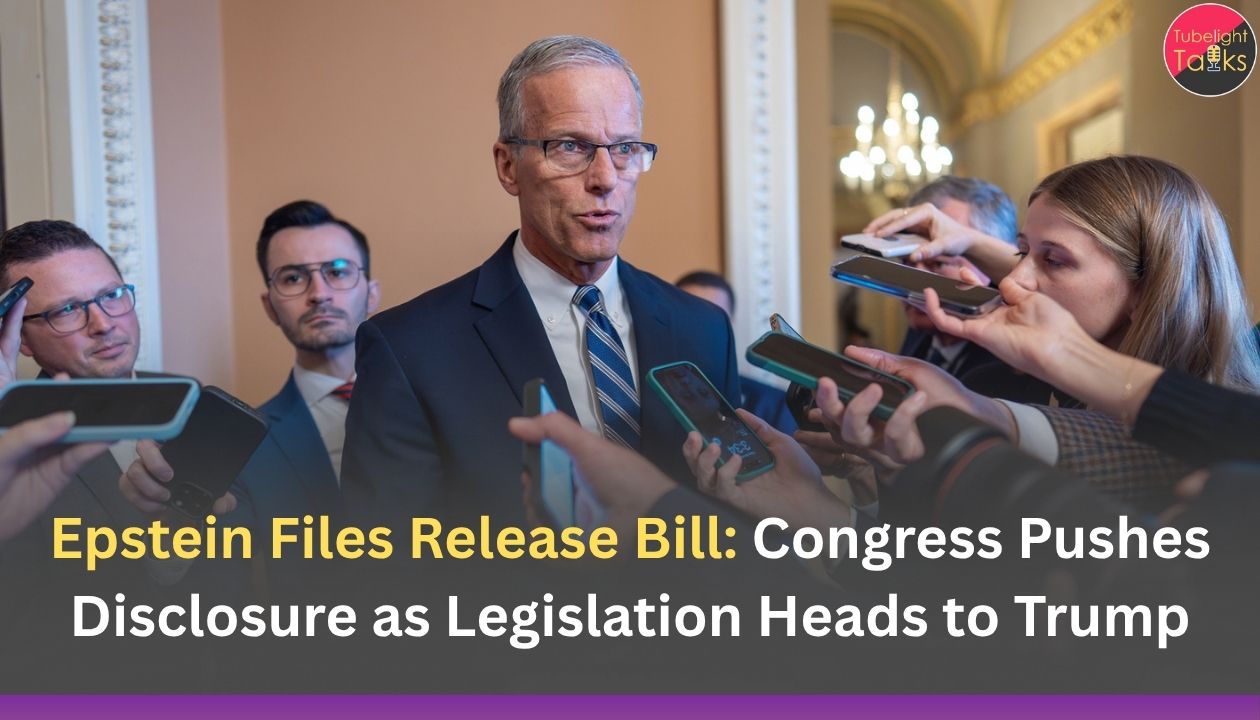Epstein Files Release Bill gained momentum after the US Congress passed landmark legislation demanding full disclosure of government files related to Jeffrey Epstein, the late financier tied to major abuse and trafficking scandals. The measure passed with near-unanimous support, fueled by intense public pressure and survivors’ demands for transparency.
Attention now shifts to President Trump, whose recent reversal after years of opposition marks a major political shift. If signed, the Justice Department will be required to release thousands of pages of investigative records, with redactions only for victim privacy and ongoing cases. This long-awaited move could finally shed light on unanswered questions surrounding Epstein, his associates, and the circumstances of his death.
Decisive Congressional Action
A Political Reversal and Overwhelming Vote
The legislation’s journey began as a longshot bid in July 2025, when a bipartisan coalition of lawmakers bypassed traditional controls to bring the measure to the floor. Public demand surged as more survivors and advocates called for transparency.
Two days after President Trump switched his stance and supported the bill, the House voted 427-1 to mandate the release of all non-classified files, including records on Epstein’s prison death and correspondence about federal investigations. The Senate swiftly followed, marking one of the year’s most bipartisan moments.
What the Bill Requires
Once signed, the bill requires the Justice Department to disclose nearly 100,000 pages of files, spanning multiple investigations and figures, including communications about Ghislaine Maxwell. Attorney General Pam Bondi confirmed the department’s readiness, noting the victims’ privacy will remain protected and sensitive material will be redacted.
There are stipulations for reporting the nature of withheld or redacted content, ultimately preventing the administration from hiding data due to embarrassment, political sensitivity, or reputational harm. Some lawmakers, including Massie and Greene, have pledged to publicly read the names of accused individuals on the House floor to ensure accountability if necessary.
Context—Long Fight for Disclosure
Survivor and Public Demands Spur Action
For years, survivors of Epstein’s abuse, journalists, and advocates have called for full disclosure, suspecting wide-reaching networks of complicity and possible cover-ups. Many believe the files could reveal deeper ties among prominent politicians, businessmen, and foreign dignitaries.
Epstein, who died in federal custody in 2019 awaiting prosecution for sex trafficking, was linked with influential individuals worldwide. Previous attempts to release details were thwarted by claims of national security, privacy concerns, and alleged ongoing investigations. President Trump initially resisted, dismissing demands as a hoax, before reversing course under mounting public and political pressure.
Bill’s Safeguards
To balance transparency and ongoing justice, the bill enables redactions for victims’ identities, classified data, and open investigations or prosecutions. However, it blocks officials from concealing details for reasons of political embarrassment or reputational harm. Mandatory follow-up reports will describe every redaction and withheld file, fortifying the law’s aim for maximum disclosure. Proponents insist this safeguard is critical to avoid selective secrecy.
What Happens if Signed
Justice Department Procedures
If President Trump signs the bill, the Justice Department has 30 days to release the files. They must also provide a report within 15 days detailing materials withheld or redacted, and cannot use reasons like protecting reputation or embarrassing officials to justify secrecy. This tight timeline and restrictive redaction rules respond to public demands for fast and meaningful release.
Anticipated Public Reaction
Public interest is intense, with anticipation fueled by years of mystery and speculation over the extent of Epstein’s network. Survivor groups have hailed the passage as a major step towards justice, though advocates remain watchful for attempts at delay or excessive redaction.
Media outlets and social networks are primed for a flood of analysis once the files become public. Video coverage and press statements show a wide emotional response:
Key Facts
– Congress passed the bill 427 to 1 in the House and unanimously in the Senate.
– The bill compels release of nearly 100,000 pages of files and communications, including investigative material on Epstein’s death and associates.
– Redactions are limited to privacy of victims, classified data, or ongoing cases, not issues of embarrassment or political sensitivity.
– The Justice Department must release all permissible files within 30 days and file a redaction report within 15 days.
– President Trump, formerly a vocal opponent, now pledges to sign the bill under public and political pressure.
– Survivors and advocates have welcomed the move as a turning point in the search for justice.
Expert Reflections
Political Analysts
Political experts view the bill’s passage as an extraordinary moment of bipartisan unity, given the controversy surrounding Epstein’s case and the fierce public demand for truth. The House’s near-unanimous vote and the president’s change of stance underscore the pressure both from constituents and advocacy groups.
Legal and Survivor Advocate Perspective
Legal analysts caution that while the bill is strong, the Justice Department’s right to withhold information on ongoing cases could still limit transparency. Survivor advocates, meanwhile, argue the measure is long overdue and hope its implementation leads to systemic changes in handling abuse cases. Congressional statements echo these sentiments, emphasizing transparency and justice.
The Road Ahead
Challenges Remain
Even if the bill becomes law, questions remain about how much information will see daylight and what will remain shielded. Potential for new prosecutions, diplomatic fallout, and painful revelations for those named looms large in the weeks ahead.
Path to Accountability
For survivors and their supporters, this bill is a crucial milestone, but many stress that true justice depends on more than document releases—it will mean vigilance in uncovering what remains hidden and ensuring those responsible are held accountable.
Also Read: Trump Approval Rating 2025: President’s Support Plunges Amid Soaring Prices and Scandal
FAQs: Understanding the Epstein Files Release Bill
1. Congressional Process: How did Congress unite to pass this bill?
A bipartisan coalition led the charge amid significant public outcry, overcoming months of political opposition to secure passage.
2. Release Timeline: What deadlines does the Justice Department face?
Once signed, the department has 30 days to release, and 15 days to report on redactions or withheld content.
3. Privacy Protections: How are victims safeguarded?
Victims’ identities and abuse-related materials will be redacted, with firm legal requirements to avoid exposing sensitive personal information.
4. Redaction Limits: What information cannot be withheld?
Details cannot be kept secret for embarrassment, political sensitivity, or reputational harm, only for privacy, classification, or active cases.
5. Potential Impact: What could the files reveal?
The files may provide new insight into the network around Epstein, prompt further investigation, and spark debate on accountability and justice for survivors.










